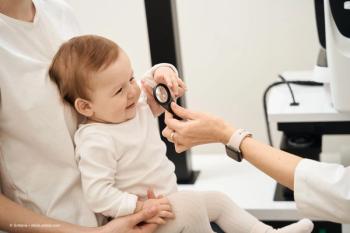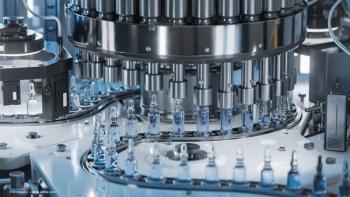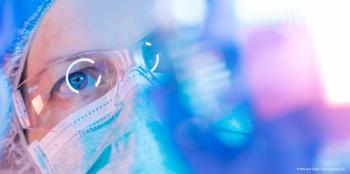
Decreasing burden of nAMD therapy
Investigators optimistic about sustained-release ranibizumab delivery based on phase II LADDER study
Patients with neovascular agerelated macular degeneration treated with ranibizumab 100 mg/mL delivered via the port delivery system in a phase II study went a median of 15 months before needing a device refill. A phase III study is under way.
Reviewed by Carl D. Regillo, MD
Ranibizumab 100 mg/mL delivered via the port delivery system (PDS) (Genentech) holds promise for providing safe and effective durable control of neovascular age-related macular degeneration (nAMD) in patients with anti-VEGF responsive disease, according to results of the LADDER study.
The phase II clinical trial was designed to characterize the durability and safety of the device. The durability results were very promising and exceeded expectations, and the safety profile looked good, especially after introducing modifications to the surgical technique, said Carl D. Regillo, MD, study investigator, and chief of the Retina Service, Wills Eye Hospital, Philadelphia.
“The techniques for device implantation and refilling are unique, but with training and meticulous care, they can be readily and safely adopted by vitreoretinal surgeons,” Dr. Regillo added. In LADDER, 220 patients were randomly assigned 3:3:3:2 to treatment with PDS 10, 40, or 100 mg/mL or intravitreal ranibizumab 0.5 mg (Lucentis, Genentech). The PDS-a scleral-based intravitreal reservoir releasing ranibizumab via passive diffusion-was refilled as needed based on protocol-defined criteria for identifying disease activity. Patients in the ranibizumab group received monthly intravitreal injections.
Time until the first need for implant refill was analyzed as the primary end point. The results showed a clear dose response, with the interval being longest in the PDS 100 mg/mL group. Median time to first refill was 15 months in the PDS 100 mg/mL group, 13.0 months for the 40 mg/mL group, and 8.7 months in the PDS 10 mg/mL group.
Among patients in the PDS 100 mg/mL group, 93% had not yet met refill criteria at 3 months, 80% still did not need a refill at 6 months, and 69% went at least 9 months without a refill.
Functional and anatomic outcomes for patients receiving the PDS 100 mg/mL implant were comparable to those in the monthly ranibizumab group. Overall, the implant insertion surgery and refill procedures were well tolerated, and there were no meaningful differences between treatment arms in systemic safety, Dr. Regillo said.
Ladder design
Patients were eligible for LADDER if they had been newly diagnosed with nAMD within the previous 9 months, received at least two prior anti-VEGF injections with the last one being ranibizumab at least 7 days prior to the screening visit, demonstrated response to prior anti-VEGF treatment, and had Snellen equivalent best-corrected visual acuity (BCVA) of 20/20 to 20/200.
The four treatment arms were well-balanced in their baseline demographic and ocular characteristics. Across the groups, mean BCVA was about 20/40, mean time from nAMD onset was 3 to 4 months, and mean number of prior antiVEGF treatments was 2.7 to 3.1.
In the PDS arms, the criteria used to determine need for device refilling were: increase in central foveal thickness ≥75 μm compared with the average of the last two visits or ≥100 μm compared with the lowest on-study measurement; decrease in BCVA ≥5 ETDRS letters compared with the average of the last 2 visits or ≥10 ETDRS letters compared with the best on-study measurement; or new macular hemorrhage.
The primary end point analysis was done after the last entered patient reached the 9-month visit, which occurred when the median time on-study was 16.8 months.
“As expected, the treatment burden in the ranibizumab arm at the primary end point was 16.8 injections, but it was only 2.4 for the PDS 100 mg/mL group,” Dr. Regillo said.
Across the PDS treatment arms, the BCVA outcomes were also best in the highest dose group. Beginning at the month 2 visit, BCVA gains were virtually identical at each monthly follow-up in the PDS 100 mg/mL and monthly ranibizumab 0.5 mg treatment groups.
At month 9, mean change from baseline BCVA was 5 letters in the PDS 100 mg/mL group and 3.9 letters in the monthly ranibizumab group. The visual gains were maintained in the high-dose PDS group through follow-up that was available to month 18.
“Data on central foveal thickness showed good exudative control that was also maintained throughout followup and favored the high-dose PDS arm,” Dr. Regillo said.
Safety
Vitreous hemorrhage developed in 50% of the first 22 patients who had the PDS implanted. Enrollment was stopped, and the surgical procedure modified to include photocoagulation of the uvea before entry into the vitreous cavity.
Among patients who had the device placed using the new technique, the rate of vitreous hemorrhage dropped to below 5%. Rates of conjunctival erosion, retinal detachment, and infection were 1% to 2%. The incidence of cataract was 7.6% of eyes receiving the PDS and 7.3% in the intravitreal ranibizumab group.
Surgical steps
The implant is placed in the superotemporal quadrant of the pars plana about 4 mm posterior to the limbus in a one-time outpatient surgical procedure done in an operating room under local anesthesia with sedation.
Surgeons make a small, full-thickness scleral cutdown and photocoagulate the uvea once it is exposed. The vitreous is entered with a 3.2- mm blade, and the filled device is then inserted.
“The implant fits securely in the sclera and the only sutures needed are for closing the overlying conjunctiva,” Dr. Regillo said.
Implant refilling is an office-based procedure performed using a proprietary needle inserted into the device through the conjunctiva.
“From the patient’s standpoint, the postoperative care and recovery from the implantation is similar to that of patients undergoing cataract surgery with the use of eye drops for a few weeks and relatively quick healing, and for the refill procedure, the patient experience is similar to an in-office intravitreal injection in terms of being well-tolerated, but it takes a bit more time to perform,” Dr. Regillo said.
ARCHWAY, a phase III study comparing PDS 100 mg/mL refilled every 24 weeks with monthly intravitreal ranibizumab 0.5 mg, was launched in September 2018 and has a planned enrollment of 360 patients.
“We are very excited to see the first true sustained-release platform for an anti-VEGF agent making it into the pivotal trial phase,” he said.
“This is a large study with many participating centers, and great effort is being made to optimize safety through extensive training of new investigators,” Dr. Regillo added.
Disclosures:
Carl D. Regillo, MD
E: cregillo@midatlanticretina.com
Dr. Regillo receives research grant support from and is a consultant to Genentech.
Newsletter
Keep your retina practice on the forefront—subscribe for expert analysis and emerging trends in retinal disease management.















































